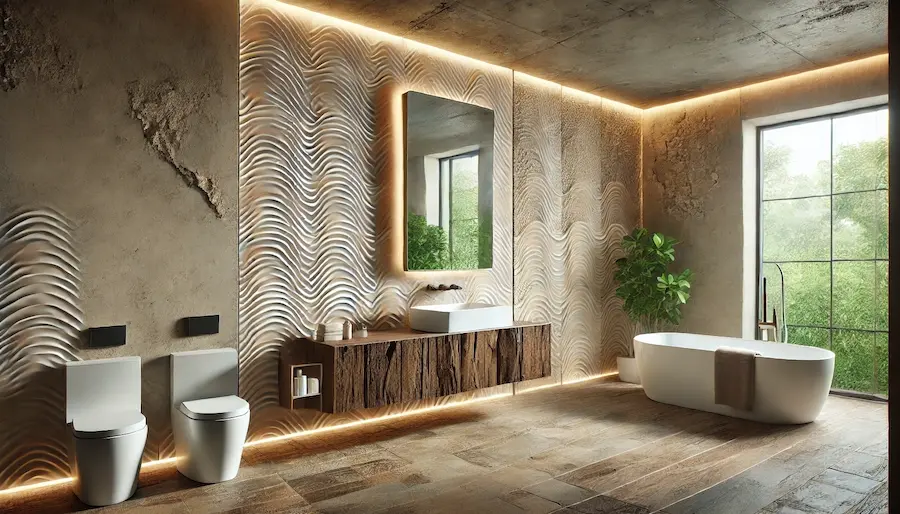Incorporating texture into bathroom design has become a prominent trend, adding depth, interest, and a tactile quality to the space. This article explores the concept of textured bathrooms, tracing their history, identifying key features, discussing applications, and offering considerations for those looking to embrace this design approach.
Introduction to Textured Bathrooms
A textured bathroom utilizes various materials and finishes to create surfaces that are not entirely smooth, introducing visual and tactile diversity. This design strategy enhances the sensory experience, making the bathroom more engaging and inviting. Textures can be introduced through tiles, wall treatments, fixtures, and accessories, contributing to a dynamic and personalized space.
History and Origins of Textured Bathrooms
The use of texture in interior design is not new; it has roots in various architectural styles and periods. In bathrooms, the incorporation of textured elements gained prominence with the advent of materials like ceramic and stone tiles, which allowed for diverse surface finishes. The Arts and Crafts movement emphasized handcrafted details, including textured surfaces, influencing bathroom designs of that era. In recent years, there has been a resurgence in the appreciation for artisanal and natural materials, leading to a renewed interest in textured bathroom designs.
Key Features of Textured Bathrooms
- Textured Tiles: Tiles with raised patterns, such as 3D designs, ridges, or natural stone imitations, are commonly used to introduce texture. They can be applied to walls, floors, or as accent pieces to create focal points.
- Natural Materials: Incorporating materials like stone, wood, or concrete adds organic texture, enhancing the bathroom’s aesthetic appeal. For example, stone tiles can provide a rugged, natural feel, while wood elements introduce warmth and grain patterns.
- Wall Treatments: Techniques such as textured paint, embossed wallpaper, or plaster finishes can add depth to bathroom walls, creating a unique and personalized environment.
- Accessories and Fixtures: Textured bath mats, towels, and fixtures with matte or brushed finishes contribute to the overall tactile experience, adding layers of interest to the space.
Applications of Textured Bathrooms
- Accent Walls: Creating a textured accent wall behind a vanity or bathtub serves as a focal point, adding visual interest without overwhelming the space. For instance, using embossed wavy tiles can evoke the calming effect of water, enhancing the bathroom’s ambiance.
- Shower Areas: Incorporating textured tiles in shower enclosures not only enhances aesthetics but also provides practical benefits, such as improved slip resistance. Textured surfaces can create a spa-like atmosphere, elevating the shower experience.
- Flooring: Textured floor tiles can add character and improve safety by providing additional grip, making them both a stylish and functional choice for bathroom floors.
- Ceilings: Though less common, textured ceilings can add an unexpected element of interest, contributing to a cohesive and immersive design.
Considerations When Choosing Textured Elements
- Maintenance: Textured surfaces may require more frequent cleaning, as grooves and patterns can trap dust and moisture. Selecting materials that are resistant to mold and mildew is essential for maintaining hygiene.
- Balance: It’s important to balance textured elements with smooth surfaces to prevent the space from feeling too busy or overwhelming. Strategic placement of textured features can create focal points without cluttering the design.
- Material Selection: Choosing appropriate materials that can withstand the bathroom’s humid environment is crucial. Natural stones should be sealed properly, and wood elements must be treated to resist moisture.
- Design Cohesion: Ensure that the textured elements complement the overall design theme of the bathroom, whether it’s modern, rustic, or traditional, to achieve a harmonious look.
Conclusion
Textured bathrooms offer a unique blend of aesthetic appeal and sensory engagement, transforming a utilitarian space into a personalized retreat. By thoughtfully incorporating textured elements through tiles, materials, and accessories, one can create a bathroom that is both functional and visually captivating. Considering factors like maintenance, balance, and material suitability will ensure that the textured features enhance the space without introducing practical challenges.
